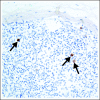Features predicting sentinel lymph node positivity in Merkel cell carcinoma
- PMID: 21300936
- PMCID: PMC5321088
- DOI: 10.1200/JCO.2010.33.4136
Features predicting sentinel lymph node positivity in Merkel cell carcinoma
Abstract
Purpose: Merkel cell carcinoma (MCC) is a relatively rare, potentially aggressive cutaneous malignancy. We examined the clinical and histologic features of primary MCC that may correlate with the probability of a positive sentinel lymph node (SLN).
Methods: Ninety-five patients with MCC who underwent SLN biopsy at the University of Michigan were identified. SLN biopsy was performed on 97 primary tumors, and an SLN was identified in 93 instances. These were reviewed for clinical and histologic features and associated SLN positivity. Univariate associations between these characteristics and a positive SLN were tested for by using either the χ(2) or the Fisher's exact test. A backward elimination algorithm was used to help create a best multiple variable model to explain a positive SLN.
Results: SLN positivity was significantly associated with the clinical size of the lesion, greatest horizontal histologic dimension, tumor thickness, mitotic rate, and histologic growth pattern. Two competing multivariate models were generated to predict a positive SLN. The histologic growth pattern was present in both models and combined with either tumor thickness or mitotic rate.
Conclusion: Increasing clinical size, increasing tumor thickness, increasing mitotic rate, and infiltrative tumor growth pattern were significantly associated with a greater likelihood of a positive SLN. By using the growth pattern and tumor thickness model, no subgroup of patients was predicted to have a lower than 15% to 20% likelihood of a positive SLN. This suggests that all patients presenting with MCC without clinical evidence of regional lymph node disease should be considered for SLN biopsy.
Conflict of interest statement
Authors' disclosures of potential conflicts of interest and author contributions are found at the end of this article.
Figures
References
-
- Allen PJ, Bowne WB, Jaques DP, et al. Merkel cell carcinoma: Prognosis and treatment of patients from a single institution. J Clin Oncol. 2005;23:2300–2309. - PubMed
-
- Medina-Franco H, Urist MM, Fiveash J, et al. Multimodality treatment of Merkel cell carcinoma: Case series and literature review of 1024 cases. Ann Surg Oncol. 2001;8:204–208. - PubMed
-
- Ott MJ, Tanabe KK, Gadd MA, et al. Multimodality management of Merkel cell carcinoma. Arch Surg. 1999;134:388–392. discussion 392-393. - PubMed
-
- Edge SB, Byrd DR, Compton CC, et al., editors. AJCC Cancer Staging Manual (ed 7) New York, NY: Springer; 2010. Merkel cell carcinoma; pp. 315–323.
-
- Voog E, Biron P, Martin JP, et al. Chemotherapy for patients with locally advanced or metastatic Merkel cell carcinoma. Cancer. 1999;85:2589–2595. - PubMed
MeSH terms
Grants and funding
LinkOut - more resources
Full Text Sources
Other Literature Sources
Medical



